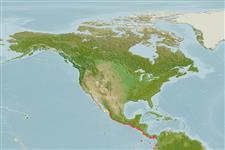Common names from other countries
>
Siluriformes (Catfishes) >
Ariidae (Sea catfishes) > Ariinae
Etymology: Occidentarius: Name Latin 'occidens' meaning west, and the genus name Arius; in reference to the restriction of the species to the EP, the western-most region occupied by ariids..
More on author: Günther.
Environment: milieu / climate zone / depth range / distribution range
Ecologia
marino; salmastro demersale; distribuzione batimetrica 6 - 107 m (Ref. 96339), usually ? - 60 m (Ref. 9271). Tropical; 24°N - 1°N
Eastern Pacific: México to Perú.
Size / Peso / Age
Maturity: Lm ? range ? - ? cm
Max length : 50.0 cm TL maschio/sesso non determinato; (Ref. 96339); common length : 25.0 cm TL maschio/sesso non determinato; (Ref. 55763)
Short description
Chiavi di identificazione | Morfologia | Morfometria
Diagnosis: This species is distinguished by the following characters: anterior cavities of lateral ethmoids (where the olfactory bulb is housed) greatly developed; bony excrescence of posterolateral process of lateral ethmoids prominent, completely closing the lateral fenestrae; basioccipital with a laminar bony crest bordering the anterior foramen of aortic tunnel (Ref. 86580).
Abundant on the continental shelf (Ref. 9271). Utilized fresh or salted, but rarely consumed (Ref. 9271). Demersal species that inhabits sandy substrates in coastal waters up to 60m deep. May be caught in nets and purse seines along with other fishes. It is sold fresh (Ref. 55763).
Life cycle and mating behavior
Maturities | Riproduzione | Spawnings | Egg(s) | Fecundities | Larve
Betancur-R, R., A. Acero P, E. Bermingham and R. Cooke, 2007. Systematics and biogeography of New World sea catfishes (Siluriformes: Ariidae) as inferred from mitochondrial, nuclear, and morphological evidence. Mol. Phylogen. Evol. 45:339-357. (Ref. 86580)
IUCN Red List Status (Ref. 130435)
CITES (Ref. 128078)
Not Evaluated
Threat to humans
Traumatogenic (Ref. 58010)
Human uses
Pesca: scarso interesse commerciale
Strumenti
Special reports
Download XML
Fonti Internet
Estimates based on models
Preferred temperature (Ref.
115969): 20.3 - 28.8, mean 26.9 (based on 68 cells).
Phylogenetic diversity index (Ref.
82804): PD
50 = 1.0000 [Uniqueness, from 0.5 = low to 2.0 = high].
Bayesian length-weight: a=0.00525 (0.00317 - 0.00870), b=3.12 (2.97 - 3.27), in cm Total Length, based on LWR estimates for this species & (Sub)family-body (Ref.
93245).
Trophic level (Ref.
69278): 3.7 ±0.0 se; based on diet studies.
Resilienza (Ref.
120179): Medio, tempo minimo di raddoppiamento della popolazione 1.4 - 4.4 anni (Preliminary K or Fecundity.).
Fishing Vulnerability (Ref.
59153): Moderate vulnerability (40 of 100).
